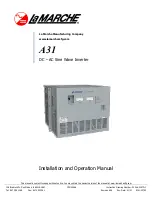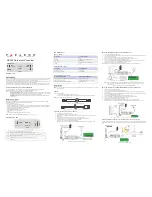
TECHNICAL INFORMATION
Copyright
Trace Engineering Company, Inc.
5916 - 195th Street N. E.
Arlington, WA 98223
Telephone: 360/435-8826
Fax: 360/435-2229
www.traceengineering.com
SW Series Inverter/Charger
Part No. 2031-5
Rev. B: Sept 1, 1999
Page
101
BATTERY SIZING
Batteries are the inverter’s fuel tank. The larger the batteries, the longer the inverter can operate before recharging
is necessary. An undersized battery bank results in reduced battery life and disappointing system performance.
Batteries should not be discharged more than 50% of their capacity on a regular basis. Under extreme conditions
(such as a severe storm or a long utility outage), cycling to a discharge level of 80% is acceptable. Totally
discharging a battery may result in permanent damage and reduced life.
For stand-alone applications, it is common to size a battery to provide between 3 and 5 days worth of storage
before the battery requires recharging. The power contribution from other charging sources is not included in this
calculation to duplicate the conditions present during a cloudy or windless period. This is often referred to as the
“number of days of autonomy”. If the system is a hybrid system with daily generator run periods, then the battery
size may be smaller. During cloudy periods the generator would be expected to run longer.
Utility connected applications often have very small batteries. If the system does not provide utility backup function,
the minimum battery capacity recommended is 320 amp-hours @ 12 vdc, 160 amp-hours @ 24 vdc, and 80 amp-
hours @ 48 vdc. If utility back up is required, larger batteries will be needed.
ESTIMATING BATTERY REQUIREMENTS
In order to determine the proper battery bank size, it is necessary to compute the number of amp hours that will be
used between charging cycles. When the required amp hours are known, size the batteries at approximately twice
this amount. Doubling the expected amp hour usage ensures that the batteries will not be overly discharged and
extends battery life. To compute total amp hours usage, the amp hour requirements of each appliance that is to be
used are determined and then added together.
You can compute your battery requirements using the nameplate rating of your appliances. The critical formula is
Watts = Volts X Amps. Divide the wattage of your load by the battery voltage to determine the amperage the load
will draw from the batteries.
If the AC current is known, then the battery amperage will be:
(AC current) X (AC voltage)
(battery voltage)
Multiply the amperage by the number of hours the load will operate and you have, reasonably enough, amp-hours.
Motors are normally marked with their running current rather than their starting current. Starting current may be 3 to
6 times running current. Manufacturer literature may provide more accurate information compared to the motor
nameplate. If large motors will be started, increase the battery size to allow for the high demand start-ups require.
Follow this procedure for each item you want to use with the inverter. Add the resulting amp hour requirements for
each load to arrive at a total requirement. The minimum properly sized battery bank will be approximately double
this amount. This will allow the battery to be cycled only 50% on a regular basis.
Table 5, Typical Wattage Of Common Appliances
TYPICAL APPLIANCE WATTS
Appliance
Watts
Appliance
Watts
One FL Light
10
Microwave (compact)
600 - 800
B&W TV (12”)
100 - 500
Microwave (full size)
1500
Color TV (19”)
150
Toaster
1000
Computer
200 - 350
Hot Plate
1800
Stereo or VCR
50
Washer/Dryer
375 - 1000
Hair Dryer or Iron
1000
Blender
400
Vacuum or coffee maker
1200
*Refrigerator (3 cu ft)
180
3/8” Drill
500
*Refrigerator (12 cu ft)
480
*
Refrigerators and icemakers typically only run about 1/3 of the time, therefore the running wattage is 1/3 of the total
wattage of the appliance.
= DC amps
Summary of Contents for SW II - REV 4.01
Page 151: ......
















































